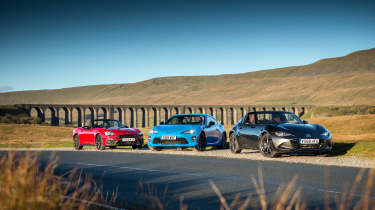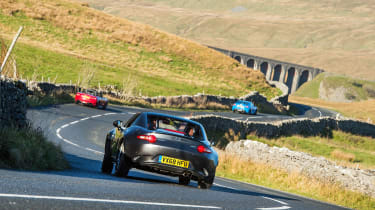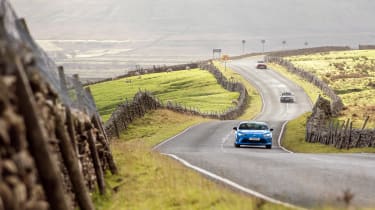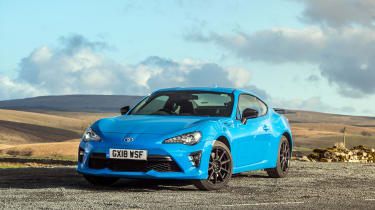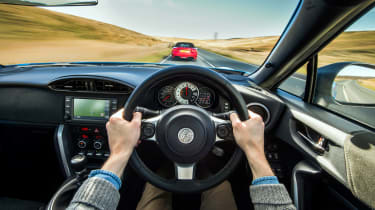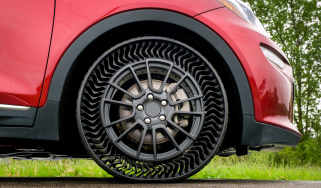Toyota GT86 v Mazda MX-5 v Abarth 124 Spider – lightweight sports car shootout
Three affordable sports cars from Japan and, er, Japan battle it out on the Yorkshire Dales
This is cause for celebration. Ready to tackle one of the best roads across the Yorkshire Dales are three rear-wheel-drive sports cars, each with a manual gearbox, each for under – and in some cases well under – thirty thousand pounds. Heck, two of them even come with naturally aspirated engines. That’s a recipe hard to find at any price these days, and yet here we are, about to pitch the newly updated Mazda MX-5 against its two key rivals, and they’re all cars that are available for the same price as a middling Golf Estate. Moreover, our chosen Mazda roadster for this test is the RF version, the one with the metal folding targa roof panel, so along with the fully enclosed Toyota GT86 and the traditional soft-top equipped Abarth 124, we’ve got all permutations of the lightweight but mainstream sports car covered.
This trio has scrapped before, in some form at least, the GT86 eclipsing the first-gen Mk4 MX-5 RF in a former test (evo 234), and while the regular Fiat 124 Spider has previously lost out to the Mazda (issue 228), the punchy little Abarth version – this example currently run on the evo Fast Fleet and winning plenty of friends – has never met the other pair in a straight fight. Unfortunately, Fiat and Abarth have both taken the 124 Spider off the order books as of 2020, but they are prolific in the second-hand market.
Click on the links below for our full reviews of each of our triple test's contenders...
The specs
On paper, the enhancements to the latest 2-litre MX-5 appear to answer most of our criticisms of the old car. Until now, there was a definite case for preferring the sweeter 1.5-litre version, but an extra 500rpm at the top of the rev range, along with 24 additional horses (now 181bhp) and the promise of a more tuneful motor should be just what the little roadster needs. As for the angry Abarth, one of the many great achievements of ex-Fiat boss, the late Sergio Marchionne, was the deal he struck with Mazda to redesign and rebirth the MX-5 into the 124. The Mazda’s naturally aspirated 2-litre engine is swapped for a Fiat 1.4-litre turbo and, in Abarth spec in particular, brings a chunk more torque with it as a result (184lb ft to the Mazda’s 151), along with the least amount of power here: 168bhp. Essentially, though, the 124 is, turbo motor aside, all but identical to the MX-5 beneath the skin, give or take a pound or two less spring stiffness and a cloth hood that requires muscle power rather than the press of a button to raise or lower.
And then we have the GT86, as divisive as ever and here in Blue Edition specification, which not only brings distinctive Electric Blue paintwork but also a small black wing at the back, a set of Sachs dampers, black 17-inch alloy wheels and beefed-up brakes by Brembo. It’s powered, of course, by one of Subaru’s naturally aspirated flat-fours, and the 197bhp 2-litre all-aluminium unit needs to be rotating at 6400rpm before it produces its not exactly epic 151lb ft, although to my ears it does sound good up at those revs and, as we’ll discover, feels more sporting than the others if you’re prepared to rag it.
Blue Edition spec lifts the price of the GT86 by £1695 to £28,980, but it’s not the most expensive car here – that honour goes to the £29,625 Abarth. The 2-litre MX-5 RF, meanwhile, starts at £26,595 if you want a version with the uprated Bilstein sports suspension, as here, and if you don’t mind canvas above your head you can get that figure down below £25k.
On paper this trio are pretty closely matched for pure, straight-line performance, especially the MX-5 and Abarth. These two actually share the same 6.8sec 0-62mph time, while the GT86 is, according to the official numbers, a touch slower at 7.6sec, but then despite its 197bhp it’s still the heaviest, at a claimed 1240kg. To be fair to Toyota that’s still admirably light, it’s just that Mazda went to extraordinary lengths to cut the kilos during the Mk4 MX-5’s development, with the result being that even in top-spec RF form it weighs just 1073kg (the soft-top Abarth is 13kg lighter still).
On the road
The Abarth, initially, feels a fair bit quicker than the others in that you don’t have to put anywhere near as much effort in via the throttle to get the same or better rewards back, certainly in terms of mid-range acceleration. It also sounds by far the fruitiest to begin with, possibly with too much boom from its exhaust between 3500 and 5500rpm, although at idle it emits a guttural kind of noise that’s oddly reminiscent of a high-speed, diesel-engined powerboat. It sounds great, though, just sitting there percolating at idle. By comparison the others make almost no noise at all until you scream them.
But despite its initially strong showing, especially on the aural front, the Spider is also softer and lazier generally compared with the others, and the further you go in it – and the harder you drive it – the more obvious this becomes. The Abarth offers a simple, readily accessible sort of fun, and there are times when its rather approximate and even slightly wayward dynamics are weirdly a positive, making the driver feel like a hero as they fight the little roadster into following their command. Whereas in the GT86, and to a lesser extent the MX-5 as well, the polar opposite is true: the harder you go, the better they get; the GT86 especially.
There’s something so fundamentally right about the Toyota, and it comes at you from all sorts of different directions at once. For starters it looks the business, particularly in Blue Edition form. So before you even climb into it you can’t help thinking that it somehow looks more serious in its intent to be ‘a sports car’ than the other two. It just looks proper somehow, and it feels exactly the same when you climb inside.
The driver’s seat has great support in all the right places (whereas the Mazda and Abarth seats both lack support across the shoulders) and you also sit several inches lower in the Toyota than you do in the others. Again, this makes it look and feel more sporting during the first few seconds you spend inside it. Same goes for the instruments, steering wheel and gearlever, and the pedals, which are absolutely spot-on in their design and placement down there in the footwell. You can heel and toe in the GT86 in your sleep, so perfectly weighted and located are its pedals, whereas it’s not quite so easy in the Mazda and Abarth – which obviously share a pedal box – because their accelerators aren’t high enough in relation to their brake pedals and require more of a prod to dial up the revs. Thankfully, the MX-5’s steering wheel now offers reach as well as rake adjustment, so taller drivers will feel a good deal more comfortable, and hence able to exploit better the Mazda’s considerable talents.
These are little things that make a surprisingly big difference when taken as a whole, and that’s before you’ve gone anywhere near a decent bit of road to throw the cars at, and to drive and compare them across. This arrives courtesy of the B6255, which spears its way across the Dales between Ingleton and Castle Bolton and provides us with the perfect opportunity to work out, a) if the Abarth really is as rapid as it feels when ambling around on more normal roads, at more normal speeds, b) if the MX-5 is still a sports car nowadays or has morphed into something else, and c) if the GT86 has the engine and chassis to take care of them both.
I try the Abarth first and find it a curious kind of car overall. Its suspension is surprisingly soft and benign in its response, its steering not especially crisp, its brakes oddly normal in the way they respond. There’s nothing overtly wrong with the way the Spider goes down the road: its engine and mid-range performance are genuinely impressive, and it goes hard and sounds suitably loud if you nail it in any of the first four gears. Plus the manual ’box works well enough in isolation.
Yet there’s a strange lack of precision about its dynamic personality that makes it oddly bland to interact with on roads like this. There’s nothing really to get hold of and work with to enhance the driving experience, to lift your soul when behind the wheel, and this makes the Abarth feel peculiarly flat after a while.
You just can’t take full advantage of the fact it’s a relatively lightweight, rear-wheel-drive sports car. Instead it just feels, well, like a normal car that just so happens to be dressed up to look like a sports car. Which is disappointing given the badge it wears. Were this the regular Fiat 124 Spider, such absence of true sparkle would be far easier to understand and to forgive, because in many ways the Spider is an easy enough car to get along with. It’s well made, well equipped, refined on a motorway and so on. But with that badge on its nose and tail, you’d expect it to come alive on roads like these, but for a variety of reasons it never really happens.
Not like it does in the others, at any rate. I drive the MX-5 next across the moors and instantly it feels more engaging, more like an actual sports car, even though there are plenty of similarities between it and the Abarth, such as the driving position, the instruments, the whole interior in fact, give or take a badge here and there. Yet on the move the MX-5 has an urgency to it that the Abarth lacks. Its suspension is a touch firmer – although as ever allows surprisingly large roll angles – giving it more precision on turn-in especially. This gives the steering more response and more feel, while the Mazda’s brake pedal has a fabulous immediacy that is again absent from the Spider.
As a result, and despite the MX-5’s fairly woeful lack of mid-range torque beside the Abarth, you connect with the Mazda in a way that never occurs in the 124. You need to rev it harder, which in itself makes the MX-5 more engaging to drive because its gearbox feels sweeter and crisper than the Abarth’s. But it means you get to the end of a road like this and think, yup, I’d like to do that all over again please, this time maybe with the electric targa roof down so I can hear a bit more of that decently sporting exhaust note.
I wouldn’t say you ever quite reach genuine motoring nirvana when driving the MX-5 – it simply isn’t quick enough for that, not feeling notably more potent than before in spite of the extra horses – even if you can lean on it and slide quite easily through most corners. But it is a car you climb out of after driving it along a good road wearing a big, cheesy smile. It does the job it is supposed to do, and does it very well indeed, and after the Abarth it proves just how important the seemingly minor details are when it comes to delivering – or not – a proper sports car driving experience.
But the GT86 is the only car here that goes all the way when it comes to driver appeal. Its flat-four engine needs to be worked hard at all times if you are to get anywhere near the best out of the steering, chassis and brakes, true, but in a way this just adds to the fundamental appeal of driving the Toyota – because when you do rag it to death, it gets better and better. And it feels more natural the harder you try.
To a point where I’m not sure any more about the philosophy behind its deliberately non-grippy Prius tyres. Quite what the wisdom is in having a set of uprated Sachs dampers and then mating these with tyres that intentionally develop not much grip, I’m not entirely sure. Then again, despite this the GT86 is easily the most entertaining of these three to drive across the B6255, so who am I to argue against such logic?
Either way, the GT86 remains the car of choice in this class, and by quite some margin overall. Its chassis is still in a league of one when it comes to allowing you to indulge yourself on the public road. It’s sharp but forgiving, clean in its responses but also infinitely adjustable. The Toyota’s steering is also much sweeter and delivers a lot more feel through the rim than the others, and its gearbox is a thing of wonder. You need to use it a lot more often than you do in the Abarth, yes, but that’s all part of the game in the GT86, and it’s a game that takes you to another level on roads like this. Plus it has rear seats and a much bigger boot than the others into the bargain.
In the end the Toyota wins, and wins easily, as long as you don’t want top-down motoring, while the MX-5 remains as good as it ever was and the Abarth is maybe just a touch disappointing. Others may not agree, but some car is the GT86, always was, always will be.
